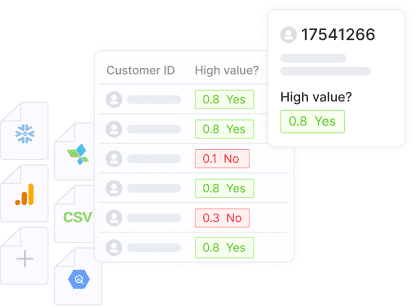In a nutshell:
- Feature engineering is crucial in machine learning as it transforms raw data into a format that models can use effectively.
- It helps extract meaningful signals and improve model performance by creating new variables and highlighting important patterns.
- Real-world examples show how engineered features can provide valuable insights that raw data alone cannot.
- Investing in quality feature engineering can significantly enhance the performance of predictive models.
- Consider using automated platforms like Pecan to streamline the feature engineering process and build powerful predictive models faster.
Watch our CEO and co-founder, Zohar Bronfman, explain this topic above — or keep reading for more!
Have you ever wondered why data pros spend so much time tinkering with data before it even touches a machine-learning model? The answer lies in a crucial process called feature engineering.
But what exactly is feature engineering, and why is it so important in AI and predictive analytics? Let's dive into this fascinating topic and see how it can make or break your machine-learning projects.
What is Feature Engineering?
Feature engineering is the secret sauce that transforms raw data into something a machine-learning model can use. What does that mean in practice?
Imagine you're a chef preparing ingredients for a gourmet meal. You don't just throw whole vegetables and raw meat into a pot. You carefully chop, season, and prepare each ingredient. Feature engineering is similar, but instead of food, we're preparing data.
In essence, feature engineering is the process of extracting and defining variables from your raw data that machine learning models will use. It's about transforming your data into a form that best represents the problem you're trying to solve. This process could involve creating new variables, transforming existing ones, or combining data to highlight important patterns.
Why is Feature Engineering Crucial?
You might wonder, "Can't we just feed raw data into a machine-learning model and let it figure things out?" Well, not quite. Here's why feature engineering is so important:
- Raw data is often incompatible with model requirements. Machine learning algorithms have specific expectations about the structure and format of input data. Raw business data rarely meets these expectations out of the box.
- It helps extract meaningful signals. By engineering features, we're essentially helping the model focus on what's important. We're using our domain knowledge to guide the model towards relevant patterns in the data.
- It can significantly improve model performance. Well-engineered features can make the difference between a model that barely works and one that provides accurate, actionable predictions.
Think of feature engineering as giving your model a pair of glasses. Without them, the model might see the world as a blur of colors and shapes.
With proper feature engineering, everything suddenly comes into focus, allowing the model to make sense of what it sees.
Real-World Examples of Feature Engineering
Let's make this concept more concrete with an example. Imagine you're working with transactional data for an e-commerce business. Your raw data might include things like transaction amounts and dates for each customer.
But is this enough for a predictive model to work with? Probably not.
Here's where feature engineering comes in. You might create a new feature that aggregates the total amount spent by each customer over the last three months. This single engineered feature captures valuable information about customer behavior that wasn't explicitly present in the raw data.
But that's just the tip of the iceberg. Feature engineering could involve countless other transformations:
- Calculating the average transaction size for each customer
- Determining the frequency of purchases
- Identifying the most common product categories for each customer
Each engineered feature provides a new lens through which the model can view the data, potentially uncovering important patterns that drive predictive accuracy.
Invest in Quality Feature Engineering
Feature engineering is a critical step in the machine learning pipeline, bridging the gap between raw data and predictive insights. It's a process that combines domain expertise, creativity, and technical skill to transform data into a form that machine learning models can effectively use.
By mastering feature engineering, you can dramatically improve the performance of your predictive models and unlock valuable insights from your data.
Ready to take your predictive analytics to the next level? Don't let feature engineering challenges hold you back.
Get a demo of Pecan today and discover how our predictive analytics platform can streamline your feature engineering process with smart automation, allowing you to quickly build powerful predictive models. Don't wait – start turning your raw data into actionable predictions faster than ever.



